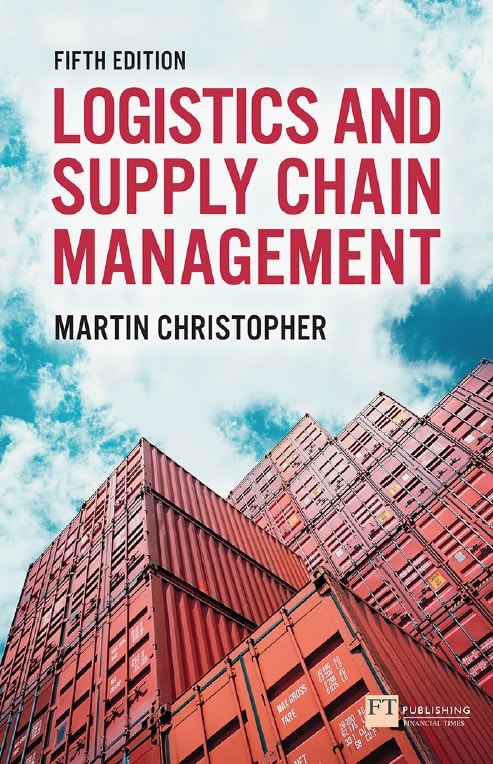
Contents
About the author viii
Preface xiii
Publisher’s acknowledgements xiv
1 Logistics, the supply chain and competitive strategy 1
Supply chain management is a wider concept than logistics 2
Competitive advantage 4
The supply chain becomes the value chain 10
The mission of logistics management 11
The supply chain and competitive performance 13
The changing competitive environment 14
2 Delivering customer value 27
The marketing and logistics interface 28
Delivering customer value 29
What is customer service? 31
The impact of out-of-stock 33
Customer service and customer retention 36
Market-driven supply chains 39
Defining customer service objectives 43
Setting customer service priorities 47
Setting service standards 51
3 Going to market 57
Distribution channels are value delivery systems 58
Innovation in the distribution channel 61
The omni-channel revolution 64
Omni-channel retailing 66
4 Measuring logistics costs and performance 69
Logistics and the bottom line 70
Logistics and shareholder value 73
Logistics cost analysis 78
The concept of total cost analysis 79
Understanding the cost-to-serve 82
Customer profitability analysis 84
Direct product profitability 90
Cost drivers and activity-based costing 91
5 Matching supply and demand 95
The lead-time gap 95
Improving visibility of demand 97
The supply chain fulcrum 99
Forecast for capacity, execute against demand 101
Demand management and planning 101
Collaborative planning, forecasting and replenishment 106
6 Creating the responsive supply chain 111
Using the volume/variability matrix 115
Product ‘push’ versus demand ‘pull’ 117
The Japanese philosophy 122
The agile supply chain 123
The foundations of agility 126
A routemap to responsiveness 130
7 Strategic lead-time management 135
Time-based competition 135
The concept of lead-time 139
Logistics pipeline management 143
Reducing logistics lead-time 147
8 The synchronous supply chain 155
The extended enterprise and the virtual supply chain 156
The role of information in the virtual supply chain 158
Laying the foundations for synchronisation 161
‘Quick response’ logistics 163
Production strategies for QR 166
Logistics systems dynamics 167
9 Complexity and the supply chain 173
The sources of supply chain complexity 174
The cost of complexity 180
Product design and supply chain complexity 180
Mastering complexity 181
10 Managing the global pipeline 185
The trend towards globalisation in the supply chain 187
Gaining visibility in the global pipeline 192
Financing global supply chains 194
Organising for global logistics 194
Thinking global, acting local 199
The future of global sourcing 200
11 Service logistics 203
What is a service? 203
Buying performance 204
The service dominant logic 205
The trend to ‘servitisation’ 205
Implications of servitisation for logistics 207
The critical role of capacity 207
Service supply chain processes 210
Managing the service supply chain 212
12 Managing risk in the supply chain 215
Why are supply chains more vulnerable? 216
Understanding the supply chain risk profile 219
Managing supply chain risk 224
Achieving supply chain resilience 232
13 The era of network competition 237
The new organisational paradigm 238
Collaboration and trust in the supply chain 240
Reducing costs through collaborative working 243
‘Co-opetition’ – co-operating with competitors 245
Managing the supply chain as a network 246
Supply chain orchestration 247
From 3PL to 4PL™ 249
The last word 250
14 Overcoming the barriers to supply chain integration 253
Creating the logistics vision 254
The problems with conventional organisations 254
Developing the logistics organisation 258
Logistics as the vehicle for change 262
Benchmarking 263
15 Creating a sustainable supply chain 269
The triple bottom line 269
Greenhouse gases and the supply chain 271
Reducing the transport-intensity of supply chains 273
Beyond the carbon footprint 274
Reduce, re-use, re-cycle 277
The impact of congestion 279
16 The supply chain of the future 283
Emerging mega-trends 284
Shifting centres of gravity 285
Supply chain governance and compliance 286
The need for adaptability 287
Seeking structural flexibility 288
2020 vision 291
Waste in the supply chain 291
The New Industrial Revolution 292
Seven major business transformations 294
The implications for tomorrow’s logistics managers 296
Index 301
Preface
Logistics and supply chain management are now firmly established as critical business concerns. Many companies have appointed Directors and Vice-Presidents who are responsible for ensuring the cost-effective operation of the ‘end-to-end pipeline’ that links the supply side of the business with the end market. When the first edition of this book was published in 1992, the practice of logistics and supply chain management was still in its infancy even though the underlying ideas had been around for a while.
In preparing this fifth edition of Logistics and Supply Chain Management I have continued to maintain the focus of the book around the role that logistics and supply chain management play in achieving competitive advantage. The premise that has underpinned this book since the first edition is that businesses compete as supply chains rather than as stand-alone companies. Converting this idea from an abstract concept into real-world practice is still proving a challenge for many organisations. Hopefully this book will provide some guidance on how that transformation can be achieved.
Supply chains today operate in a world where the rate of change continues to increase. As we enter an era that some have termed ‘The New Industrial Revolution’ much of the conventional wisdom that has been the basis for supply chain design and thinking will have to be questioned. Hence the emphasis in the book on the need to develop logistics and supply chain solutions that are flexible and capable of adapting quickly to changes in the business environment.
In writing any book there will be many sources of inspiration and this is certainly the case with this current volume. Over the years I have the good fortune to work with thought-leaders in logistics and supply chain management – both academics and practitioners – from around the world and I have learned much from them. Instead of attempting to list them I would rather acknowledge with gratitude the collective role they have played in shaping the ideas that I present in this book. I thank them all.
